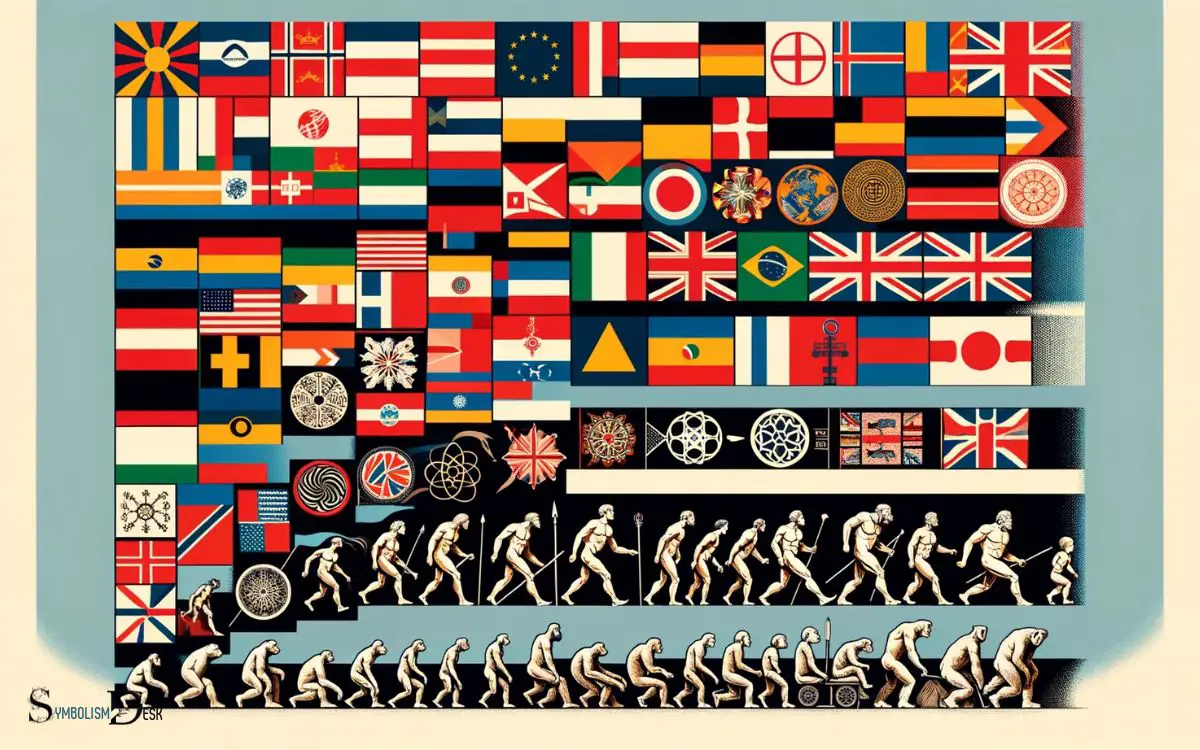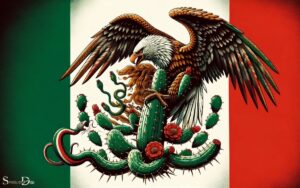What Does the Symbol on the El Salvador Flag Mean? Freedom!
The symbol on the flag of El Salvador represents the country’s quest for freedom, its commitment to republican democracy, and its history of indigenous and Spanish influence.
It comprises a triangle with five volcanoes, the blue-white-blue stripes, and the words ‘Dios, Union, Libertad’ (God, Union, Liberty).
The flag of El Salvador features a coat of arms which includes the following elements:
- A Triangle: Symbolizing equality and the three branches of the Salvadoran government.
- Five Volcanoes: Representing the five member states of the United Provinces of Central America.
- Phrygian Cap: A symbol of freedom atop a staff before a sun with a golden sky, indicating the emergence of a new nation.
- Rainbow: Signifying peace.
- The Date: 15 September 1821, the day of El Salvador’s independence from Spain.
- The Motto: ‘Dios, Union, Libertad’ encapsulates the core values of the nation.
For example, the five volcanoes on the flag not only represent the five original states but also the natural volcanic landscape of the country.
The flag’s emblem, a poignant reminder of El Salvador’s struggle for sovereignty and unity, continues to evoke national pride and a shared sense of purpose among Salvadorans.

Key Takeaway
Historical Origins of the Symbol

The historical origins of the symbol on the El Salvador flag can be traced back to the country’s indigenous heritage and its connection to the ancient Pipil civilization.
The symbol at the center of the flag is a depiction of the national coat of arms, which was inspired by the seal of the 16th-century indigenous leader, Atlacatl. This symbol represents the rich cultural history and the resilience of the indigenous peoples of El Salvador.
The blue and white stripes surrounding the emblem are said to be inspired by the Argentine flag, symbolizing the unity of Central America.
The flag as a whole reflects the country’s deep-rooted connection to its indigenous roots and its aspirations for unity and peace. It serves as a powerful representation of El Salvador’s history and national identity.
Symbolic Elements and Colors

Symbolic of the nation’s heritage and aspirations, the flag of El Salvador incorporates specific colors and elements that hold deep significance. The flag consists of a horizontal tricolor of blue, white, and blue stripes with the country’s coat of arms in the center.
Each of these elements carries symbolic meaning, representing the nation’s history, values, and natural beauty.
The following table provides an overview of the colors and elements of the flag:
| Color/Element | Symbolic Representation |
|---|---|
| Blue | Represents the sky and the ocean that borders the country, symbolizing perseverance and vigilance |
| White | Symbolizes peace and harmony, as well as the unity and solidarity of the Salvadoran people |
| Coat of Arms | Depicts the country’s national heritage, with the triangle signifying equality and the five volcanoes representing the five former states of the Central American Union |
Understanding the symbolic elements and colors of the flag is crucial for comprehending its cultural significance and interpretation.
Cultural Significance and Interpretation

Embedded in the colors and elements of the El Salvador flag is a rich cultural significance that reflects the nation’s heritage and values.
The flag’s cultural significance and interpretation can be understood through the following:
- National Identity: The blue and white stripes represent the country’s position between the Pacific Ocean and the Caribbean Sea, while the coat of arms symbolizes El Salvador’s rich history and the importance of freedom and sovereignty.
- Historical Legacy: The flag’s design pays homage to the United Provinces of Central America, under which El Salvador gained independence.
- Symbolism: The flag’s emblem features a bold message with a volcanic landscape, the shining sun, a rainbow, and a Phrygian cap, representing liberty and the country’s commitment to freedom and equality.
Evolution of the Flag Design

Once a symbol of the nation’s historical evolution, the design of the El Salvador flag has undergone several significant changes. The evolution of the flag design reflects the country’s shifting political and social landscape.
Below is a table summarizing the key changes in the design of the flag:
| Flag Version | Description | Period |
|---|---|---|
| Original Flag | Blue and white stripes with a coat of arms in the center | 1821-1865 |
| First Official Flag | Blue and white stripes with a different coat of arms | 1865-1912 |
| Current Flag | Blue and white stripes with the national emblem | 1912-Present |
The evolution of the flag design not only reflects historical shifts but also symbolizes the nation’s journey towards its contemporary identity. This transformation has had a profound impact on the flag’s contemporary significance and symbolism.
What Do the Symbols on Flags Represent?
The symbols on the american flag hold significant meaning. The thirteen stripes represent the original thirteen colonies, while the fifty stars symbolize the states in the Union. These symbols on the American flag embody the country’s history, unity, and the enduring spirit of its people.
Why is Freedom an Important Symbol on the El Salvador Flag?
The symbolism of Nepal’s flag lies in its unique shape and elements, representing independence, unity, and national pride. Similarly, freedom is an important symbol on the El Salvador flag. It embodies the country’s hard-fought struggle for liberation from oppression and its commitment to democratic values. The flag, adorned with the national coat of arms, serves as a constant reminder of the Salvadoran people’s resilience and the enduring significance of freedom.
Contemporary Impact and Symbolism

Representing the nation’s modern identity and values, the symbolism of the emblem on the El Salvador flag holds significant contemporary relevance.
The emblem on the flag continues to serve as a powerful representation of El Salvador’s cultural heritage, national pride, and aspirations for the future.
Its contemporary impact and symbolism are evident in:
- National Unity: The emblem’s depiction of the bold and resolute stance of the ancient tribes symbolizes the unity of the Salvadoran people in the face of present-day challenges.
- Cultural Resilience: The emblem’s emphasis on the indigenous roots of the nation reflects the enduring strength and resilience of El Salvador’s diverse cultural heritage.
- Aspirations for Progress: The emblem’s incorporation of the national motto ‘Dios, Unión, Libertad’ (God, Union, Liberty) embodies the country’s ongoing pursuit of prosperity, unity, and freedom for its citizens.
Conclusion
The symbol on the El Salvador flag holds deep historical and cultural significance, representing the country’s heritage and values.
Its evolution over time reflects the changing social and political landscape, while its contemporary impact continues to inspire pride and unity among the people.
The symbol serves as a powerful reminder of the nation’s resilience and identity, evoking a sense of reverence and admiration for El Salvador’s rich history.







